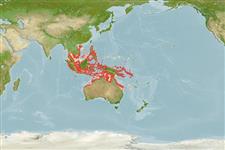Common names from other countries
Environment: milieu / climate zone / depth range / distribution range
Ecologie
marien rifbewoner; standvastig; diepte 1 - 50 m (Ref. 9710). Tropical; 20°N - 24°S, 97°E - 163°E (Ref. 5222)
Western Pacific: Philippines to Australia (Dampier Islands, off Western Australia to the Capricorn Islands, of the southern Great Barrier Reef); including Palau, New Britain, and the Solomon Islands.
Grootte / Gewicht / Leeftijd
Maturity: Lm ? range ? - ? cm
Max length : 55.0 cm TL mannelijk / geslacht onbekend; (Ref. 118794)
Dorsale stekels (totaal) : 9; Dorsale zachte stralen (totaal) : 15 - 17; Anale stekels: 3; Anale zachte stralen: 7 - 8. Juveniles dark brown with bright yellow dorsal, anal, pelvic and tail fins. At size about 9 cm, small scattered blue dots appear and yellow on fins begins to recede (Ref. 37816); characterized further by brown to reddish brown color, usually mottled; head, body and fins covered with numerous white to bluish spots; several pale bars evident on side; scales ctenoid scales on body including abdomen; greatest body depth 2.6-3.0 in SL; rounded caudal fin; pelvic fins 1.8-2.1 in head length (Ref. 90102).
Inhabits shallow protected coastal reefs, in seagrass beds, and in coral-rich areas (Ref. 9710, 48635). Feeds on crustaceans and fishes (Ref. 37816). Solitary (Ref 90102). Protogynous hermaphrodite (Ref. 089707).
Levenscyclus en paargedrag
Maturities | Voortplanting | Spawnings | Egg(s) | Fecundities | Larven
Heemstra, P.C. and J.E. Randall, 1993. FAO Species Catalogue. Vol. 16. Groupers of the world (family Serranidae, subfamily Epinephelinae). An annotated and illustrated catalogue of the grouper, rockcod, hind, coral grouper and lyretail species known to date. Rome: FAO. FAO Fish. Synop. 125(16):382 p. (Ref. 5222)
Status op de Rode Lijst van het IUCN (Ref. 130435)
CITES (Ref. 128078)
Not Evaluated
Gevaar voor de mens
Harmless
Gebruik door de mens
Visserij: van minder commercieel belang
Tools
Speciale rapporten
Download XML
Internetbronnen
Estimates based on models
Preferred temperature (Ref.
115969): 25.6 - 29, mean 28.3 (based on 758 cells).
Fylogenetische diversiteitsindex (Ref.
82804): PD
50 = 0.5000 [Uniqueness, from 0.5 = low to 2.0 = high].
Bayesian length-weight: a=0.01349 (0.00847 - 0.02147), b=3.02 (2.89 - 3.15), in cm Total Length, based on LWR estimates for this species & Genus-body shape (Ref.
93245).
Trofisch niveau (Ref.
69278): 4.2 ±0.74 se; based on food items.
Weerstandsvermogen (Ref.
120179): Zeer laag, minimale populatieverdubbelingstijd meer dan 14 jaar (Preliminary K or Fecundity.).
Fishing Vulnerability (Ref.
59153): High vulnerability (58 of 100).
